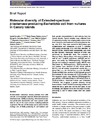Identificador persistente para citar o vincular este elemento:
http://hdl.handle.net/10553/74667
| Título: | Molecular diversity of Extended-spectrum β-lactamase-producing Escherichia coli from vultures in Canary Islands | Autores/as: | Carvalho, Isabel Tejedor Junco, María Teresa González Martín, Margarita Rosa Corbera Sánchez, Juan Alberto Suárez Pérez, Alejandro Silva, Vanessa Igrejas, Gilberto Torres, Carmen Poeta, Patrícia |
Clasificación UNESCO: | 241401 Antibióticos 3105 Peces y fauna silvestre |
Palabras clave: | Antimicrobials Escherichia coli Vultures Canary Islands |
Fecha de publicación: | 2020 | Publicación seriada: | Environmental Microbiology Reports | Resumen: | Antimicrobial resistance among isolates from wild animals is increasingly reported. Extended-spectrum beta-lactamase (ESBL)-producing Enterobacteriaceae, and particularly Escherichia coli, have spread worldwide as one of the most common multidrug-resistant organisms. The aim of this study was to determine the carriage rate of ESBL-producing E. coli isolates and their genetic characteristics in wild vultures from the Canary Islands. Faecal samples were collected from 22 apparently healthy free-ranging (wild) vulture chicks from Lanzarote and Fuerteventura (Canary Islands) during July 2019. They were seeded in MacConkey agar supplemented with cefotaxime (2 μg ml−1). Colonies with typical morphology of E. coli were identified by MALDI-TOF-MS. Antimicrobial susceptibility was done by disk diffusion. Phenotypic detection of ESBL was performed by double-disk tests. The presence of blaCTX-M, blaSHV, blaTEM, blaKPC and blaOXA-48 genes, as well as mcr-1 (colistin resistance), tetA/tetB and int1 gene, was tested by PCR/sequencing. Phylogenetic groups and multilocus sequence typing (MLST) were determined by PCR/sequencing. ESBL-producing E. coli isolates were detected in 5/22 tested animals (22.7%), and all isolates (one/animal) carried blaCTX-M genes: blaCTX-M-15 (n = 3) and blaCTX-M-55 (n = 2). ESBL-positive isolates were ascribed to phylogenetic group D (two isolates), B1 (two isolates) and A (one isolate), and five sequence types were detected (ST/phylogenetic-group/ESBL): ST515/B1/CTX-M-15, ST1290/A/CTX-M-15, ST38/D/CTX-M-15, ST457/D/CTX-M-55 and ST6448/B1/CTX-M-55; this suggests a genetic diversity among these isolates. Three CTX-M-15-producing isolates contained the blaTEM gene and one the tetA gene. To our knowledge, this appears to be the first report of ESBL-producing E. coli in vulture chicks from the Canary Islands. | URI: | http://hdl.handle.net/10553/74667 | ISSN: | 1758-2229 | DOI: | 10.1111/1758-2229.12873 | Fuente: | Environmental Microbiology Reports [EISSN 1758-2229], v. 12 (5), p. 540-547, (Enero 2020) |
| Colección: | Artículos |
Citas SCOPUSTM
9
actualizado el 30-mar-2025
Citas de WEB OF SCIENCETM
Citations
9
actualizado el 30-mar-2025
Visitas
88
actualizado el 10-feb-2024
Descargas
280
actualizado el 10-feb-2024
Google ScholarTM
Verifica
Altmetric
Comparte
Exporta metadatos
Los elementos en ULPGC accedaCRIS están protegidos por derechos de autor con todos los derechos reservados, a menos que se indique lo contrario.
